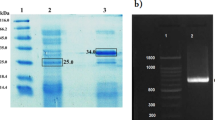Abstract
A novel crystal protein that exhibited potent cytotoxicity against human leukemic T-cells was cloned from the Bacillus thuringiensis TK-E6 strain. The protein, designated as parasporin-2Ab (PS2Ab), was a polypeptide of 304 amino acid residues with a predicted molecular weight of 33,017. The deduced amino acid sequence of PS2Ab showed significant homology (84% identitiy) to parasporin-2Aa (PS2Aa) from the B. thuringiensis A1547 strain. Upon processing of PS2Ab with proteinase K, the active form of 29 kDa was produced. The activated PS2Ab showed potent cytotoxicity against MOLT-4 and Jurkat cells and the EC50 values were estimated as 0.545 and 0.745 ng/mL, respectively. The cytotoxicity of PS2Ab was significantly higher than that of PS2Aa reported elsewhere. Although both cytotoxins were structurally related, it was thought that the minor differences found were responsible for the different cytotoxicities of PS2Ab and PS2Aa.



Similar content being viewed by others
Literature Cited
Altschul SF, Gish W, Miller W, Myers EW, Lipman DJ (1990) Basic local alignment search tool. J Mol Biol 215:403–410
Amano H, Yamagiwa M, Akao T, Mizuki E, Ohba M, Sakai H (2005) A novel 29-kDa crystal protein from Bacillus thuringiensis induces caspase activation and cell death of Jurkat T cells. Biosci Biotechnol Biochem 69:2063–2072
Berry C, O’Neil S, Ben-Dov E, et al. (2002) Complete sequence and organization of pBtoxis, the toxin-coding plasmid of Bacillus thuringiensis subsp. israelensis. Appl Environ Microbiol 68:5082–5095
Crickmore N, Zeigler DR, Feitelson J, et al. (1998) Revision of the nomenclature for the Bacillus thuringiensis pesticidal crystal proteins. Microbiol Mol Biol Rev 62:807–813
Hastowo S, Lay BW, Ohba M (1992) Naturally occurring Bacillus thuringiensis in Indonesia. J Appl Bacteriol 73:108–113
Höfte H, Whiteley HR (1989) Insecticidal crystal proteins of Bacillus thuringiensis. Microbiol Rev 53:242–255
Ito A, Sasaguri Y, Kitada S, Kusaka Y, et al. (2004) A Bacillus thuringiensis crystal protein with selective cytocidal action to human cells. J Biol Chem 279:21,282–21,286
Lee DW, Akao T, Yamashita S, et al. (2000) Noninsecticidal parasporal proteins of a Bacillus thuringiensis serovar shandongiensis isolate exhibit a preferential cytotoxicity against human leukemic T cells. Biochem Biophys Res Commun 272:218–223
Meadows MP, Ellis DJ, Butt J, Jarrett P, Burges HD (1992) Distribution, frequency, and diversity of Bacillus thuringiensis in an animal feed mill. Appl Environ Microbiol 58:1344–1350
Mizuki E, Ohba M, Akao T, Yamashita S, Saitoh H, Park YS (1999) Unique activity associated with non-insecticidal Bacillus thuringiensis parasporal inclusions: in vitro cell-killing action on human cancer cells. J Appl Microbiol 86:477–486
Mizuki E, Park YS, Saitoh H, et al. (2000) Parasporin, a human leukemic cell-recognizing parasporal protein of Bacillus thuringiensis. Clin Diagn Lab Immunol 7:625–634
Namba A, Yamagiwa M, Amano H, et al. (2003) The cytotoxicity of Bacillus thuringiensis subsp. coreanensis A1519 strain against the human leukemic T cell. Biochim Biophys Acta 1622:29–35
Nishimoto T, Yoshisue H, Ihara K, Sakai H, Komano T (1994) Functional analysis of block 5, one of the highly conserved amino acid sequences in the 130-kDa CryIVA protein produced by Bacillus thuringiensis subsp. israelensis. FEBS Lett 348:249–254
Ohba M (1996) Bacillus thuringiensis populations naturally occurring on mulberry leaves: a possible source of the populations associated with silkworm-rearing insectaries. J Appl Bacteriol 80:56–64
Ohba M (1997) Three Bacillus thuringiensis flagellar serovars widely occurring in natural environments of Japan. J Basic Microbiol 37:71–76
Ohba M, Aizawa K (1986) Insect toxicity of Bacillus thuringiensis isolated from soils of Japan. J Invertebr Pathol 47:12–20
Page RDM (1996) TREEVIEW: an application to display phylogenetic trees on personal computers. Conput Appl Biosci 13:357–358
Roh JY, Park HW, Jin BR, Kim HS, Yu YM, Kang SK (1996) Characterization of novel non-toxic Bacillus thuringiensis isolated from Korea. Lett Appl Microbiol 23:249–252
Sher D, Fishman Y, Zhang M, et al. (2005) Hydralysins, a new category of β-pore-forming toxins in Cnidaria. J Biol Chem 280:22847–22855
Thompson JD, Higgins DG, Gibson TJ (1994) CLUSTAL W: inproving the sensitivity of progressive multiple sequence alignment through sequence weighting, position-specific gap penalties and weight matrix choice. Nucleic Acids Res 22:4673–4680
Yamashita S, Akao T, Mizuki E, et al. (2000) Characterization of the anti-cancer-cell parasporal proteins of a Bacillus thuringiensis isolate. Can J Microbiol 46:913–919
Acknowledgment
This study was supported, in part, by research grant from the Ministry of Education, Culture, Sports, Science and Technology of Japan.
Author information
Authors and Affiliations
Corresponding author
Rights and permissions
About this article
Cite this article
Hayakawa, T., Kanagawa, R., Kotani, Y. et al. Parasporin-2Ab, a Newly Isolated Cytotoxic Crystal Protein from Bacillus thuringiensis . Curr Microbiol 55, 278–283 (2007). https://doi.org/10.1007/s00284-006-0351-8
Received:
Accepted:
Published:
Issue Date:
DOI: https://doi.org/10.1007/s00284-006-0351-8




